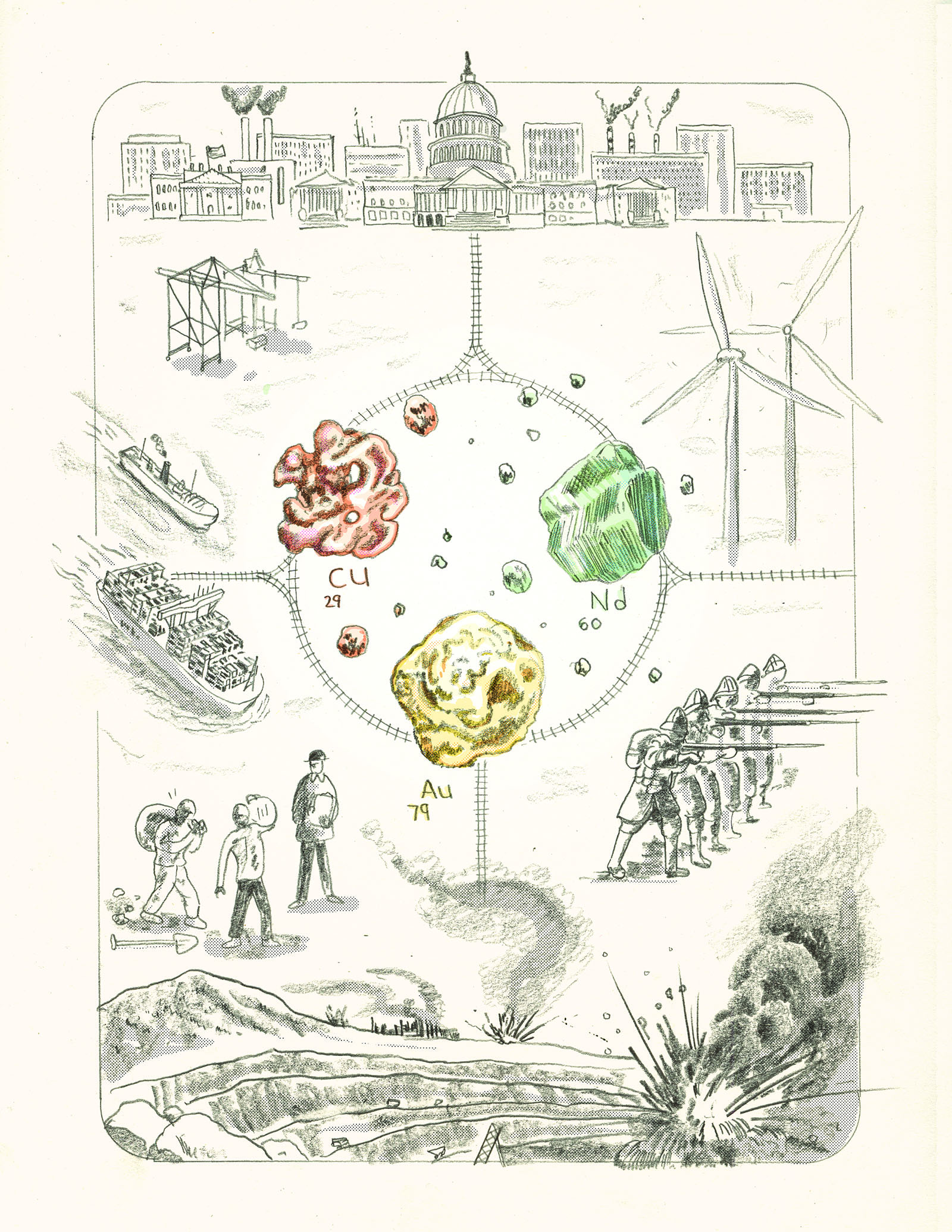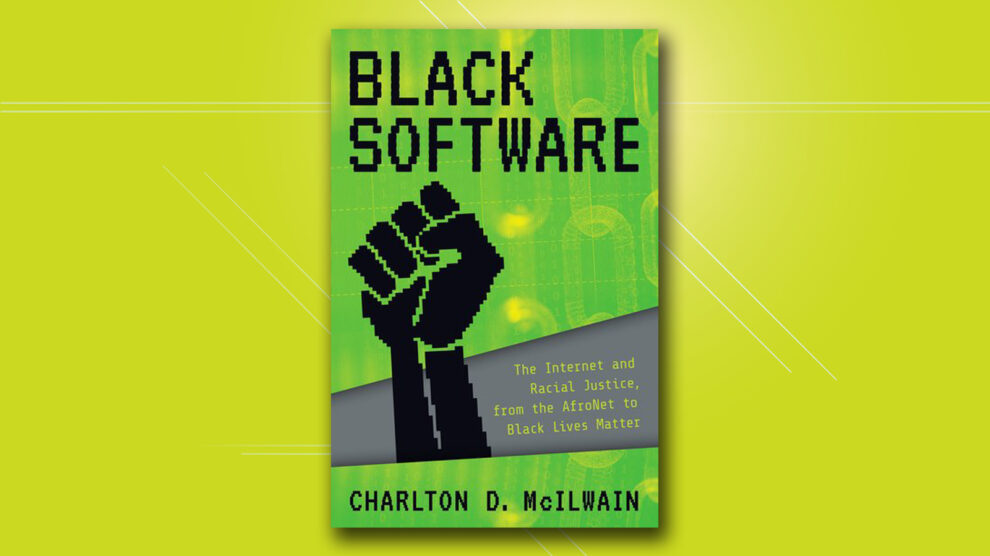The Minerals Must Flow
By Calvin Wu
Volume 25, no. 2, Bleeding Earth

Ongoing crises of planetary scale invariably compel us to seek existing or emergent solutions. Technology in the general sense, i.e., human knowledge objectified, becomes the harbinger of hope. No pandemic response is possible without vaccine research, nor is climate action without energy transition. But technology isn’t merely a construct of human ingenuity; it discloses humans’ relationship to nature. Beneath these marvels lay an array of raw materials extracted from nature, which periodizes the evolution of our species: Stone Age, Bronze Age, Iron Age, Silicon Age, and so on. What minerals define our current conjuncture? More importantly: who extracts them, where do they flow, and for what reason? As Karl Marx remarked, “the taste of the porridge does not tell you who grew the oats.”1 In advancing human knowledge and confronting planetary crises, we cannot fail to understand extraction as a historical force. Every act of extraction is a process through which technology and social relations coevolve. Every mineral tells a story of how we come to live in the world of today.
Copper Bullet
Because natural resources on our planet are not evenly distributed, the economy of extraction undergirds national and international politics. Chile, with its large copper reserves and its tumultuous and violent modern history, traces the contour of such an uneven landscape.
Like most Latin American countries, Chile gained political independence at the beginning of the nineteenth century. The power of the old feudal empires was waning and the new empires of free-enterprising entrepreneurs rose to integrate many of the former feudal colonies into the new global economy. By the 1860s, the Chilean copper mining industry produced half of the world’s copper, satisfying the growing demand during the Industrial Revolution.2 Chile was on the cusp of modernization, with booming industry and trade, but the United States had something else in mind.3 Chile would not be allowed to follow the classical development path of Western Europe.
In the 1840s, white settlers in the midwestern United States “rediscovered” copper that had been mined by Indigenous peoples.4 Looking to dominate copper production globally, the US mining industry and government employed two tactics to decimate their Chilean counterparts. First they took advantage of the mass migration into the United States during its industrial boom. Mining towns consisted almost entirely of foreign-born residents; a survey in 1888 showed that out of twelve hundred miners in Copper Harbor, Michigan, only sixty were native.5 The influx and rapid turnover of immigrants as well as latent ethnic tensions among workers prevented labor organizing. Wages were kept low so that copper could be extracted cheaply. On the other side of the supply chain, the US government enacted protective tariffs to ensure that domestic copper was used over imports from Chile. Protectionist policies also allowed the US copper industry to overproduce, driving the copper price to below its production price, making it near-impossible to compete. By the turn of the twentieth century, the US juggernaut of capital had won out. The Chilean copper industry collapsed, taking Chile’s economy with it.
The winners took all. Chile’s remaining copper deposits soon fell into the hands of US corporations. In 1904, Braden Copper Company purchased El Teniente, now the world’s largest underground copper mine.6 The United States—that is, the state-military-finance nexus and the mining corporations—“invested” half a billion dollars to take control of over 87 percent of Chilean copper production in the first quarter of the twentieth century, all the while paying 0.8 percent in taxes.7 Their grip over Chilean copper only consolidated through the twentieth century as copper became a vital resource in the endless wars waged by the United States.
But the people have agency; imperialism is always counterpoised by resistance. If the Cuban Revolution of 1959 was the wooden stick that poked the empire in the eye, then growing as a branch from the same tree was Chile’s Popular Front movement of unions, socialists, and communists.8 In 1964, a left-leaning administration headed by president Eduardo Frei Montalva took office. Running on the platform of renegotiating ownership of copper mines, Frei Montalva was not prepared for a 15 percent copper inflation.9 The cost of remunerating the US copper multinationals, Kennecott and Anaconda, would be imposed on the Chilean people.10
The Pinochet regime enacted economic policies designed by the US elite from the top down—an experiment called neoliberalism that would become the paradigm across the Global South.
And the Chilean people would tolerate neither Frei’s concessions to mining companies nor his conciliatory stance toward the Northern exploiter.11 The center did not hold. President Salvador Allende was elected in 1970 to complete the task of nationalization, despite US covert action.12 After a unanimous vote in congress, Allende reappropriated the copper mines, reclaiming the excess profits of Kennecott and Anaconda dating back to 1955.13 Chile’s act of defiance quickly reached the pinnacle of power:
Nixon: What in the hell is going on?
Connally: He’s gone back and said that the copper companies owe $700 million. … He’s thrown the gauntlet to us. Now, it’s our move.
Nixon: I have decided we’re going to give Allende the hook. … he’s an enemy.
Connally: … the only thing you can ever hope is to have him overthrown. And, in the meantime, you will make your point to prove, by your actions against him … that you are looking after American interests.14
Nixon and fellow stewards of US interests began by “making the [Chilean] economy scream.”15 First, they slashed credit to Chile from the World Bank and the International Monetary Fund.16 Then they suppressed world copper prices to reduce Chile’s major source of export income.17 Finally, through control of the media, they pinned blame for Chile’s spiraling economy on the Allende government, incited protests among opposition political groups, and funded business strikes against nationalized economic sectors.18 Allende’s decolonial project could not withstand the weight of Chile’s coveted copper (and the two bullets that ended Allende’s life in the coup d’etat).19 The succeeding Pinochet regime enacted economic policies designed by the US elite from the top down—an experiment called neoliberalism that would become the paradigm across the Global South.20
In the words of Evo Morales, who survived a similar US-orchestrated coup in Bolivia in 2019: “If the salvation of humanity is far away, it is because Washington insists on using its bullets against the world’s people.”21
Goldbug
If copper extraction shaped two centuries of Chilean history, gold extraction shaped world history since the dawn of modernity. The lust for gold drove European conquistadors to pillage all corners of the globe; accumulation of gold created the necessary condition for capitalism and empire to arise. What’s special about precious minerals like gold is their monetary function. Unlike copper that is engineered into specific commodities, whose production is determined by costs of extraction and market signals, gold has intrinsic value as transhistorical currency. Gold mining, therefore, is extremely profitable and exerts lasting effects on the world economy.
In 1886, a rich gold deposit was discovered near Johannesburg, a village with a few hundred people in the British colony of Transvaal, South Africa. In less than a decade, Johannesburg had exploded into a metropolis of one hundred thousand people comprising European settlers and African migrant workers.22 These workers were the sole source of profit in gold extraction. Since the international gold standard kept the price of gold fixed, the mine owners just needed to pay the workers as little as possible.23
To keep wages low and to minimize the cost of labor reproduction, the mining industry led by the British South Africa Company set up labor camps to house Black migrant workers from neighboring African colonies. The workers were segregated from city-dwellers, mostly white settlers who became affluent through booming commerce and manufacturing.24 This was the bloody birth of Apartheid; the extremely exploitative labor practice forged by gold mining soon weaved itself into the larger social fabric.
Accumulation South African gold in the metropole of London ensured global capitalism’s steady economic expansion.
By 1914, through the sweat of 180,000 Black migrant workers, the Transvaal gold mine alone produced a quarter of the world’s gold and two-thirds of South African exports.25 Accumulation of this vast supply of South African gold—the largest in the world—in the metropole of London (and later New York) ensured global capitalism’s steady economic expansion. When the United States superseded Britain as the hegemon in the 1940s, South African gold was diverted to Fort Knox. The US stockpile of gold empowered the dollar as the world currency, through the Bretton Woods system of fixed exchange rates.
A secure and steady supply of gold was paramount to the US imperial project. As such, South Africa’s Apartheid regime must not be jeopardized by “terrorists” such as the African National Congress.26 The anti-Apartheid movement also saw gold for what it was and rose up against the mining industry; they organized labor strikes against railways and mines, as well as guerilla attacks on company offices.27 In the 1960s, with mounting pressure from the world’s people to sanction the Apartheid regime—which the US ruling elites continued to support until the late 1980s—it became clear that the global gold supply had become unreliable.28 Many economic and political factors led to the demise of the Bretton Woods system, but at its material heart was South Africa’s gold, whose continuous growth in extraction since 1886 peaked in the same year Bretton Woods ended.29
As gold was set free to become a speculated commodity, competitive pressure of gold production increased. Mining companies in the United States, Canada, and Australia with their access to the luxury market quickly chipped away South Africa’s dominance.30 Major mining corporations like Anglo American that had operated in South Africa since 1917 withdrew capital investment.31 South Africa’s economy was in stagnation, viciously exacerbated by political turmoil during the brutal Apartheid regime. By the time Nelson Mandela and the African National Congress took power in 1994, South Africa’s economy was hovering around 0 percent GDP.32 Surrounded by hostile forces of Western capital, Mandela capitulated, turning back on the promise to nationalize the mines, and succumbing to the International Monetary Fund’s neoliberal statecraft.33
Walter Rodney wrote in 1972: “When a child ceases to be dependent upon its mother for food and protection, it can be said to have developed … dependent nations can never be considered developed.”34 Neither South Africa or Chile has overcome such dependency. Just as the gold and the copper still belong to mining corporations in the West, so their national economies are controlled by US-led global financial institutions. But the future is yet to be written; the finale will depend on the struggle of the world’s people against imperialism.
Green Elements
Empires come and go, and they hardly go without convulsion. We live in such a time of great geopolitical conflict. Since the 1950s, China has achieved political sovereignty uniquely among countries of the Global South, and has become the world’s second largest economy.35 What China’s meteoric rise means for the global economy, especially with regards to extraction, is of utmost political and ecological significance.
Leading up to the recent United Nations Climate Change Conference in Glasgow (COP26), China and India as top carbon emitters could not escape bombardment from Western media.36 However, even without pointing to the farce of Western climate inaction, a rudimentary understanding of global capitalism makes it abundantly clear that it is the West who set up workshops in the Global South, running on fossil fuel and cheap labor, to produce commodities they themselves consume. Such narratives about China’s “responsibility”—even voiced by some on the left—in fact, serve an ulterior purpose.
The purpose is to paint China as a rival on equal footing with the United States, create a new Orientalism, and displace people’s anti-imperialist sentiments.37 And here is where the third story about extraction is unfolding.
If empire is about the subjugation of the entire world to its interests, China’s command of 85 percent of the world’s rare earth elements (REEs) is less than ideal for the US ruling elites.38 REEs have become increasingly crucial in advanced technologies: semiconductors in smartphones and laptops, LEDs, batteries, and lasers. In terms of developing low-carbon energy, REEs make up solar panels, wind turbines, and even nuclear reactors. To overcome strategic weakness due to REE scarcity, the United States invested heavily to strengthen and diversify the current REE supply chain, develop advanced extraction techniques, intensify extraction, and expand the US sphere of influence where REEs are located.39 These are all parts of the Biden administration’s trillion-dollar infrastructure bill; while advertised in the name of “clean energy,” the essence is one of empire building.40
To understand our path forward, we need a theory of imperialism as a political-economic process linking the past and present.
Is clean energy really clean, when its key component produces highly toxic externalities?41 Toxic not only in the sense of environmental and health impact, but also of the heightening of political tension between the United States and China, which in turn presses mining companies to extract more REE from the earth. Indigenous communities across North America are already fighting the encroachment of REE mining.42 Radioactive wastes extracted in Australia are shipped to the poorer Malaysia for processing.43 And as a testament to Africa’s unbroken dependency on the West, its untapped REE resources are now coveted by the United States in a maneuver to tackle China’s REE monopoly, putting the continent once again at the center of inter-state conflict.44
Where does this put us? To understand our path forward, we need a theory of imperialism as a political-economic process linking the past and present. At the first level, we must not allow greenwashing of the US imperial project. We must not fall into the death trap—like the Second International before us on the eve of the First World War—of following the ruling class into war.45 At a deeper level, we can begin to unveil the secrets behind seemingly neutral practices of extraction. The minerals under our feet condition how we live on the surface. With the power of knowledge, we can then begin to change it.
—
The belief that the advancement of technology would eventually solve society’s problems is especially prevalent among scientists. Such an ecomodernist view is rooted in capitalism’s “triumphs” in the nineteenth century and the second half of the twentieth century. As these stories illustrate, the so-called triumphs were built upon the exploitation of Africa, Latin America, and the Global South in general. To regard the extraction of natural resources as a way to prosperity and to see technological advancement as the panacea—to be an ecomodernist—is to erase the suffering of the world’s people in the march toward modernity.46
In a time of deepening crisis, science and technology as embodied knowledge and labor are necessary to our survival. But this science must not only follow ecological principles in amending the rift between humanity and nature, it also needs to be embedded in the social metabolism of our species as a whole. Solutions to the problems facing humanity are not in the mantle of a far-out asteroid that spawns quixotic technologies.47 There can be no utopia, no progress, and no salvation of science without foretelling the story of how the people fought imperialism, and won.
Notes
- Karl Marx, Capital: A Critique of Political Economy Volume One (New York: Penguin Books, 1976), 290.
- William W. Culver and Cornel J. Reinhart, “Capitalist Dreams: Chile’s Response to Nineteenth-Century World Copper Competition,” Comparative Studies in Society and History 31, no. 4 (1989): 722–44., https://www.jstor.org/stable/179076.
- John Mayo, “The Development of British Interests in Chile’s Norte Chico in the Early Nineteenth Century,” Americas 57, no. 3 (2001): 363–94, https://www.jstor.org/stable/1007561.
- John R. Halsey, Prehistoric Copper Mining in Michigan: The Nineteenth-Century Discovery of “Ancient Diggings” in the Keweenaw Peninsula and Isle Royale (University of Michigan Press, 2018).
- Joan Underhill Hannon, “Ethnic Discrimination in a 19th-Century Mining District: Michigan Copper Mines, 1888,” Explorations in Economic History 19, no. 1 (January 1, 1982): 28–50, https://doi.org/10.1016/0014-4983(82)90003-1; see also Larry Lankton, Cradle to Grave Life: Work, and Death at the Lake Superior Copper Mines (New York: Oxford University Press, 1991).
- “Records of Kennecott Copper Corporation, Braden Unit, 1938-1953,” Arizona Archives Online, accessed August 1, 2022, http://www.azarchivesonline.org/xtf/view?docId=ead/uoa/UAMS158.xml.
- Income tax was not yet instituted in Chile in the first quarter of the twentieth century. The 0.8 percent figure was calculated based on infrastructure investment and expenditure on other externalities. See Steven S. Volk, “Mine Owners, Moneylenders, and the State in Mid-Nineteenth-Century Chile: Transitions and Conflicts,” The Hispanic American Historical Review 73, no. 1 (February 1, 1993): 67–98, https://doi.org/10.1215/00182168-73.1.067; Theodore H. Moran, Multinational Corporations and the Politics of Dependence: Copper in Chile (Princeton, NJ: Princeton University Press, 1975), 22.
- For a historical timeline of Chilean people’s struggle against imperialism that culminated in Allende’s electoral victory, see Jeanne Olivier et al., “Chile: A History of Imperialism and Struggle,” Science for the People 5, no. 6 (November 1973): 8–23, 33–37, https://archive.scienceforthepeople.org/vol-5/v5n6/chile-history-imperialism-and-struggle/.
- “Increase Looms in Copper Prices; Chilean Election and Partial Strike Settlement Cited,” New York Times, September 9, 1964, https://www.nytimes.com/1964/09/09/archives/increase-looms-in-copper-prices-chilean-election-and-partial-strike.html.
- Carlos Fortin, “Compensating the Multinationals: Chile and the United States Copper Companies,” Institute of Development Studies Bulletin 7, no. 1 (April 1975): 23–29, https://doi.org/10.1111/j.1759-5436.1975.mp7001005.x.
- David R. Sands, “Chile Under Frei: The Alliance for Progress,” The Fletcher Forum 6, no. 1 (1982): 33–60, https://www.jstor.org/stable/45331066.
- “A Spoiling Operation: The 1970 Chilean Presidential Election, January 1–September 4, 1970,” Foreign Relations of the United States, 1969–1976, Volume XXI, Chile, 1969–1973, The Historian of the U.S. Department of State, https://history.state.gov/historicaldocuments/frus1969-76v21/ch2.
- Joseph Novitski, “Chile Nullifies Payments For Seized Copper Mines,” New York Times, September 29, 1971, https://www.nytimes.com/1971/09/29/archives/chile-nullifies-payments-for-seized-copper-mines-chile-nullifies.html.
- “Conversation Among President Nixon, Secretary of the Treasury Connally, the White House Chief of Staff (Haldeman), and the President’s Assistant for National Security Affairs (Kissinger),” Foreign Relations of the United States, 1969–1976, Volume XXI, Chile, 1969–1973, The Historian of the U.S. Department of State, https://history.state.gov/historicaldocuments/frus1969-76ve16/d85.
- Peter Kornbluh, “‘Make the Economy Scream’: Secret Documents Show Nixon, Kissinger Role Backing 1973 Chile Coup,” Democracy Now!, September 10, 2013, https://www.democracynow.org/2013/9/10/40_years_after_chiles_9_11.
- Paul E. Sigmund, “The ‘Invisible Blockade’ and the Overthrow of Allende,” Foreign Affairs 52, no. 2 (1974): 322–40, https://www.jstor.org/stable/20038052.
- “Memorandum From the President’s Assistant for National Security Affairs (Kissinger) to President Nixon,” Foreign Relations of the United States, 1969–1976, Volume XXI, Chile, 1969–1973, The Historian of the U.S. Department of State, https://history.state.gov/historicaldocuments/frus1969-76v21/d197.
- “Covert Action in Chile 1963-1973,” The Transnational Institute, accessed June 10, 2022, https://www.tni.org/en/archives/act/4113#IIIA.
- Ralph Miliband, “The Coup in Chile,” Jacobin, September 11, 2016, https://jacobin.com/2016/09/chile-coup-santiago-allende-social-democracy-september-11-2.
- David Harvey, A Brief History of Neoliberalism (New York: Oxford University Press, 2007).
- Vijay Pashad, Washington Bullets (New Delhi: LeWord Books, 2020).
- Alan H. Jeeves, Migrant Labour in South Africa’s Mining Economy: The Struggle for the Gold Mines’ Labour Supply, 1890-1920 (McGill-Queen’s University Press, 1985)
- Francis Wilson, Labour in the South African Gold Mines 1911–1969 (Cambridge: Cambridge University Press, 2011).
- Christo Vosloo, “Extreme Apartheid: The South African System of Migrant Labour and Its Hostels,” Image & Text, no. 34 (2020), http://dx.doi.org/10.17159/2617-3255/2020/n34a1.
- Jean Jacques Van-Helten, “Empire and High Finance: South Africa and the International Gold Standard 1890-1914,” Journal of African History 23, no. 4 (1982): 529–48, https://www.jstor.org/stable/182040; C. J. H. Hartnady, “South Africa’s Gold Production and Reserves,” South African Journal of Science 105, no. 9–10 (September/October 2009): 328–9.
- Benjamin Nimer, “Terrorism and Southern Africa,” Terrorism 13, no. 6 (January 1990): 447–53, https://www.ojp.gov/ncjrs/virtual-library/abstracts/terrorism-and-southern-africa.
- Stephen Zunes, “The Role of Non-Violent Action in the Downfall of Apartheid,” The Journal of Modern African Studies 37, no. 1 (1999): 137–69, https://www.jstor.org/stable/161471; “South Africa Detains 30 Black Labor Activists,” New York Times, May 1, 1985, https://www.nytimes.com/1985/05/01/world/south-africa-detains-30-black-labor-activists.html.
- Michael J. Graetz and Olivia Briffault, “‘A ‘Barbarous Relic’: The French, Gold, and the Demise of Bretton Woods,” in The Bretton Woods Agreement together with Scholarly Commentaries and Essential Historical Documents, eds. Naomi Lamoreaux and Ian Shapiro (Yale University Press, 2016), http://dx.doi.org/10.2139/ssrn.2827738.
- Hartnady, “South Africa’s Gold Production.”
- Nicoli Nattrass, “The Crisis in South African Gold Mining,” World Development 23, no. 5 (May 1, 1995): 857–68, https://doi.org/10.1016/0305-750X(95)00007-Y.
- Léonce Ndikumana, Karmen Naidoo, and Adam Aboobaker, Capital Flight from South Africa: A Case Study (University of Massachusetts Amherst, 2020), https://peri.umass.edu/component/k2/item/download/934_39553a1b28ef6f3a795396ed43916a78.
- “GDP growth (annual %) – South Africa,” World Bank national accounts data, accessed June 10, 2022, https://data.worldbank.org/indicator/NY.GDP.MKTP.KD.ZG?locations=ZA.
- Bill Keller, “Under Fire, Mandela Calls For Austerity,” New York Times, October 31, 1994, https://www.nytimes.com/1994/10/31/world/under-fire-mandela-calls-for-austerity.html.
- Walter Rodney, How Europe Underdeveloped Africa (New York: Verso Books, 2018), 31.
- Minqi Li, “China: Imperialism or Semi-Periphery?,” Monthly Review 73, no. 3 (July-August 2021), https://monthlyreview.org/2021/07/01/china-imperialism-or-semi-periphery/ .
- Sara Schonhardt and Scott Waldman, “U.S. Commits to Greater CO2 Reductions, China and India Do Not,” Scientific American, April 23, 2021, https://www.scientificamerican.com/article/u-s-commits-to-greater-co2-reductions-china-and-india-do-not/.
- Su-Mei Ooi and Gwen D’Arcangelis, “Framing China: Discourses of Othering in US News and Political Rhetoric,” Global Media and China 2, no. 3–4 (September 1, 2017): 269–83, https://doi.org/10.1177/2059436418756096; Qiao Collective, “Sinophobia Inc: Understanding the Anti-China Industrial Complex,” Qiao Collective, September 13, 2020, https://www.qiaocollective.com/articles/sinophobia-inc.
- Jevans Nyabiage, “China’s Dominance of Rare Earths Supply Is a Growing Concern in the West,” South China Morning Post, April 25, 2021, https://www.scmp.com/news/china/diplomacy/article/3130990/chinas-dominance-rare-earths-supply-growing-concern-west.
- Samantha Subin, “The New U.S. Plan to Rival China and End Cornering of Market in Rare Earth Metals,” CNBC, April 17, 2021, https://www.cnbc.com/2021/04/17/the-new-us-plan-to-rival-chinas-dominance-in-rare-earth-metals.html.
- Ariel Cohen and James C. Grant, “America’s Critical Strategic Vulnerability: Rare Earth Elements,” Foreign Policy Research Institute, June 22, 2021, https://www.fpri.org/article/2021/06/americas-critical-strategic-vulnerability-rare-earth-elements/.
- V. Balaram, “Rare Earth Elements: A Review of Applications, Occurrence, Exploration, Analysis, Recycling, and Environmental Impact,” Geoscience Frontiers 10, no. 4 (July 1, 2019): 1285–1303, https://doi.org/10.1016/j.gsf.2018.12.005.
- John Ahni Schertow, “Algonquin First Nations Have Serious Concerns about Proposed Rare Earth Mine on Traditional Lands,” Intercontinental Cry, May 2, 2012, https://intercontinentalcry.org/algonquin-first-nations-have-serious-concerns-about-proposed-rare-earth-mine-on-traditional-lands/.
- “Australia’s Lynas to Provide Malaysian Authorities More Info to Resume Radioactive Waste Disposal Assessment,” Reuters, April 28, 2021, https://www.reuters.com/business/environment/australias-lynas-provide-malaysian-authorities-more-info-resume-radioactive-2021-04-28/.
- Luke Tyburski, “Africa’s Real Strategic Import for the Green Economy,” Atlantic Council, March 29, 2021, https://www.atlanticcouncil.org/blogs/africasource/africas-real-strategic-import-for-the-green-economy/; Ernest Scheyder and Zandi Shabalala, “Exclusive: Pentagon Eyes Rare Earth Supplies in Africa in Push Away from China,” Reuters, June 5, 2019, https://www.reuters.com/article/us-usa-rareearths-pentagon-exclusive-idUSKCN1T62S4.
- Sean Larson, “The Rise and Fall of the Second International,” Jacobin, July 14, 2017, https://jacobin.com/2017/07/second-international-bernstein-rosa-luxemburg-unions-world-war.
- Ian Angus, “Memo to Jacobin: Ecomodernism Is Not Ecosocialism,” Climate & Capitalism, September 25, 2017, https://climateandcapitalism.com/2017/09/25/memo-to-jacobin-ecomodernism-is-not-ecosocialism/.
- Asteroid mining is a prime example of ecomodernist ideology. Proponents not only include profiteers and prominent scientists, but also self-described “socialists.” As case in point, see Nick Levine, “Democratize the Universe,” Jacobin, March 21, 2015, https://jacobin.com/2015/03/space-industry-extraction-levine and Aaron Bastani, Fully Automated Luxury Communism (New York: Verso Books, 2019).





